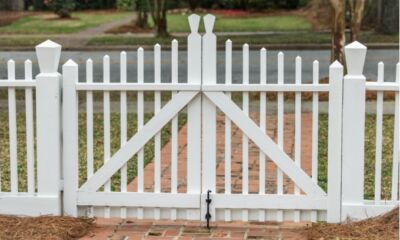How much does it cost to build a fence?
A fence can add security, privacy and style to your home. If you’re considering adding one to your property or replacing an existing one, our guide to how much you could expect to pay may be useful in helping you to decide.

A fence can add security, privacy and style to your home. If you’re considering adding one to your property or replacing an existing one, our guide to how much you could expect to pay may be useful in helping you to decide.
How much does a fence cost?
There can be big variations in the costs of building a fence. Key factors that can affect the costs include:
- the material used to make the fence
- the height and height of the fence
- land terrain and the fence’s foundations
- whether you need to remove an old fence or have gates installed.
How much does fencing cost per metre?
According to tradie listings website hipages, installing a new fence can cost between $75 and $350 per metre. As a guide, you can expect to pay an average of $50 to $120 per square metre for basic timber fencing, or up to $280 to $380 per square metre for a treated pine slat fence.
Cost of different types of fences
Another important factor that will drive the cost of a fence is the material you choose. Here’s a guide to the typical costs of some common fencing materials and styles (including labour and installation):
Cost of a picket fence
A picket fence is one of the classic types of residential fences. They are best known for their evenly spaced boards (or pickets) and are traditionally painted white. According to hipages, you can expect to pay between $105 to $235 per metre for the supply and installation of a basic PVC picket fence. Alternatively, picket fences can be built using timber which may be more expensive (see below).
Cost of a timber pailing fence
A timber fence is another popular and affordable option. It costs approximately $75 to $120 per metre for treated pine paling fencing, $80 to $125 per metre for hardwood paling fencing. However, you may also need to factor in the cost of staining or painting the timber.
Cost of a Colorbond fence
Colorbond-coated steel fencing is a durable and low-maintenance type of fencing. According to hipages, Colorbond fencing normally costs approximately $75 to $100 per metre, but you should allow for the cost of installation which can add an extra $68 to $78 per metre.
Cost of a glass fence
Typically used for pool fencing, a glass fence can add a contemporary and open look to your outdoor areas. Generally, you can choose between frameless glass or semi-frameless glass. According to hipages, the average-sized fence can cost $1,400 to $2,300, though frameless glass fencing is likely to cost more – around $600 to $1,000 per metre.
Cost of a brick fence or wall
Brick fences are known for their strength and stability. They are often made using a combination of materials – for example, a brick wall with wrought iron inserts. For a standard brick fence however, hipages says this will cost between $550 and $880 per metre. At the top end of the scale, you could be looking at $800 to $1,200 per metre for a sandstone and timber fence.
Cost of a wrought iron fence
If you’re looking to install a more decorative fence, wrought iron is another option. The cost starts from about $115 per metre, according to hipages, and can go as high as $600 per metre for a higher quality product.
 24hr approval available
24hr approval available
 Apply in full online
Apply in full online
 Fraud protection
Fraud protection

0% p.a. interest rate on balance transfers for 24 mths. Rate reverts to 21.99% p.a. Balance transfer fee of 2% applies. Offer available until further notice. See provider website for full details. Terms and conditions apply.
 24hr approval available
24hr approval available
 Apply in full online
Apply in full online
 Fraud protection
Fraud protection

0.00% p.a. interest rate on balance transfers for 24 mths. Rate reverts to 21.99% p.a. Balance transfer fee of 2% applies. Offer available until further notice. See provider website for full details. Terms and conditions apply.
 24hr approval available
24hr approval available
 Apply in full online
Apply in full online
 Fraud protection
Fraud protection
Canstar may earn a fee for referrals from its website tables, and from Sponsorship or Promotion of certain products. Fees payable by product providers for referrals and Sponsorship or Promotion may vary between providers, website position, and revenue model. Sponsorship or Promotion fees may be higher than referral fees. Sponsored or Promotion products are clearly disclosed as such on website pages. They may appear in a number of areas of the website such as in comparison tables, on hub pages and in articles. Sponsored or Promotion products may be displayed in a fixed position in a table, regardless of the product’s rating, price or other attributes. The table position of a Sponsored or Promoted product does not indicate any ranking or rating by Canstar. For more information please see How We Get Paid.
What are the options to finance your fence?
Personal savings: can be an option if you have savings tucked away. It’s an interest-free option, and there is always the possibility that a supplier may offer a cash discount. Compare savings accounts with Canstar.
Personal loan: could also fund the work. This could be a secured loan, or an unsecured loan. It’s worth keeping in mind though, that interest rates are generally higher for personal loans than for home loans, and it’s a good idea to read the lender’s terms and conditions first. Compare personal loans with Canstar.
Credit card: may also be possible, depending on the cost and your ability to repay the debt quickly, to pay for the job on a credit card. There could be some fringe benefits for doing so, such as extra insurance cover in some cases (read the card’s Product Disclosure Statement to find out the conditions of the cover). Keep in mind that credit card interest rates are typically much higher than home or personal loans, and interest can quickly accumulate on large balances, so it is a good idea to weigh up your options and consider them carefully. If you don’t think you’ll be able to pay off the card’s balance in full each month, it may be worth reconsidering whether a credit card is the right option for you. Compare credit cards with Canstar.
Tips to help you save money on your fence
Do it yourself
You may be able to save some cash by constructing the fence yourself rather than paying a professional to do it. However, this may not be appropriate (or easy to do) in some circumstances. For example, it may be more difficult to install a fence on a sloping rather than level surface. If going down the DIY route, you’ll also need to consider any machinery hire costs if you don’t have the equipment yourself, as well as fencing regulations that may apply in your area (more on this below).
If building a timber fence, you may also be able to save money by staining or painting the fence yourself. Fence stains, brushes and paint are widely available from hardware stores.
Remove the old fence yourself
If you’re replacing an old fence and you decide to enlist the help of a professional fence installer, you may be able to cut costs by removing the old fence yourself.
The downside is that it involves some work. If there is a substantial quantity of old fencing, you may want to pay for professional waste removal. This can cost around $79 per cubic metre, according to Serviceseeking, or you could hire a skip bin at a cost of around $75 per square metre.
If the old fence is in a usable condition, you could try and sell it through sites like Gumtree.
Prepare the fence site
Taking a DIY approach to site preparation is another way of reducing costs. In particular, creating clear access for the installers can cut the time (and potentially cost) to do the job.
What are your responsibilities when building a fence?
When installing a fence, you should be aware of any fencing regulations that apply in your state, territory or local council. For example, you may need a permit before you can build a fence over a certain height.
If you’re thinking of building a dividing or boundary fence between your property and your neighbour’s property, it’s a good idea to talk to your neighbour first so that you can agree on the type of fencing and height, and obtain a couple of quotes. Generally, both you and your neighbour will need to equally share the cost of building and maintaining a dividing fence. However, it’s a good idea to read up on the local laws that apply to you.
What are the requirements for pool fences?
It’s particularly important to ensure you meet pool fencing requirements. Each state and territory has different minimum safety requirements for pool fences in place to prevent children from drowning.
Different standards apply in a few states, however there are some requirements around pool fencing common to all states and territories. These include:
- The fence must be at least 1.2 metres high all the way around
- The gap between the ground and the bottom of the fence must be no bigger than 100mm
- The gap between the panels or bars of the fence must be no bigger than 100mm
- The gate must open outwards away from the pool area and must be self-closing or self-latching
- There must be no climbable objects, like trees or furniture, within 900mm of the pool fence.
As pool fencing regulations can vary according to where you live, it’s important to talk to your fence builder and/or your local government before installing a pool fence to ensure you’re meeting the relevant legal requirements.
→ Renovating a home could change what insurance cover you may need.
Compare home and contents insurance providers.
-
Additional repayments
-
Redraw facility
-
Top-up facility
-
Application fee: $0
-
Annualised fee: $0
-
Loan terms available: 1 year to 7 years
-
Additional repayments
-
Redraw facility
-
Top-up facility
-
Application fee: $0
-
Annualised fee: $0
-
Loan terms available: 5 years
-
Additional repayments
-
Redraw facility
-
Top-up facility
-
Application fee: $0
-
Annualised fee: $0
-
Loan terms available: 3 years to 7 years
Fast quote. No account required.
Won't affect your credit score. GET YOUR RATE NOW.
-
Additional repayments
-
Redraw facility
-
Top-up facility
-
Application fee: $575
-
Annualised fee: $0
-
Loan terms available: 3 years to 7 years
Canstar may earn a fee for referrals from its website tables, and from Sponsorship or Promotion of certain products. Fees payable by product providers for referrals and Sponsorship or Promotion may vary between providers, website position, and revenue model. Sponsorship or Promotion fees may be higher than referral fees. Sponsored or Promotion products are clearly disclosed as such on website pages. They may appear in a number of areas of the website such as in comparison tables, on hub pages and in articles. Sponsored or Promotion products may be displayed in a fixed position in a table, regardless of the product’s rating, price or other attributes. The table position of a Sponsored or Promoted product does not indicate any ranking or rating by Canstar. For more information please see How We Get Paid.
Main image source: Jorge Salcedo/Shutterstock.com
This article was reviewed by our Editor-in-Chief Nina Rinella before it was updated, as part of our fact-checking process.

The comparison rate for all home loans and loans secured against real property are based on secured credit of $150,000 and a term of 25 years.
^WARNING: This comparison rate is true only for the examples given and may not include all fees and charges. Different terms, fees or other loan amounts might result in a different comparison rate.

Up to $4,000 when you take out a IMB home loan. Minimum loan amounts and LVR restrictions apply. Offer available until further notice. See provider website for full details. Exclusions, terms and conditions apply.
 Owner occupied
Owner occupied
 20% min deposit
20% min deposit
 Redraw facility
Redraw facility
Try our Home Loans comparison tool to instantly compare Canstar expert rated options.
The comparison rate for all home loans and loans secured against real property are based on secured credit of $150,000 and a term of 25 years.
^WARNING: This comparison rate is true only for the examples given and may not include all fees and charges. Different terms, fees or other loan amounts might result in a different comparison rate.










